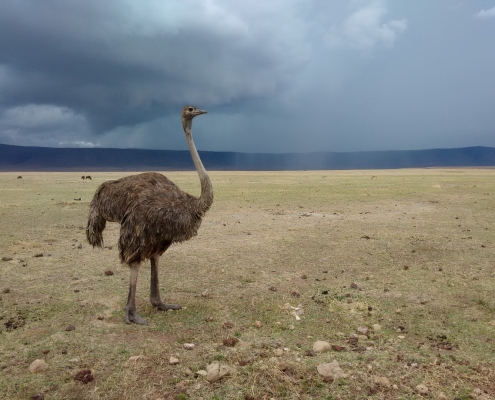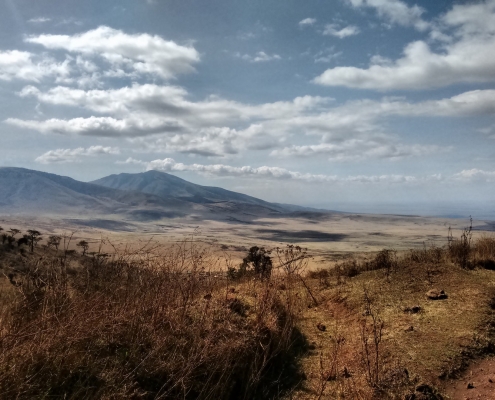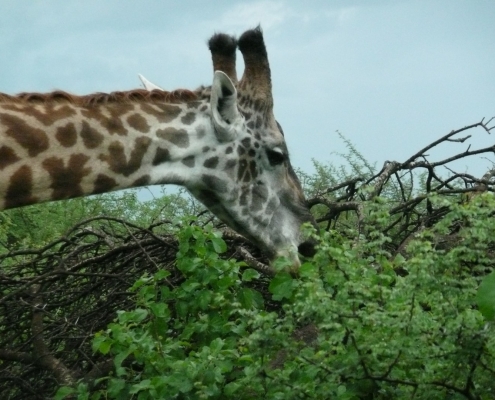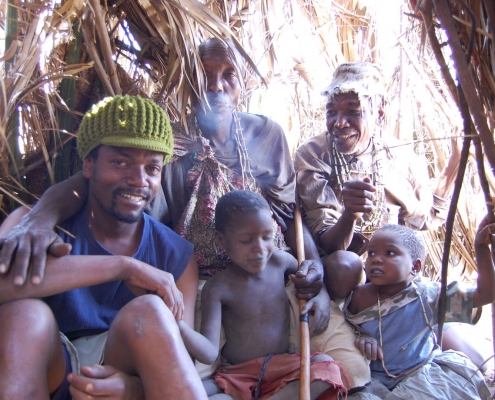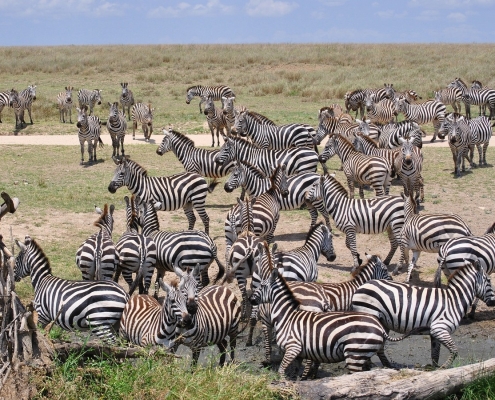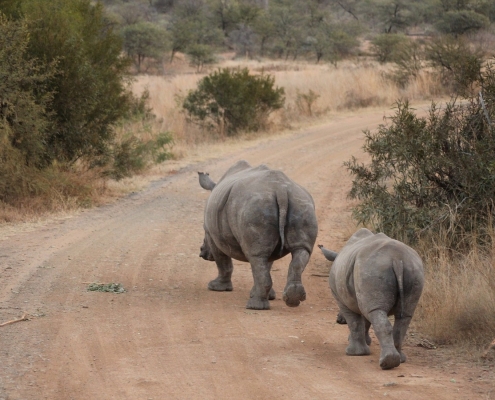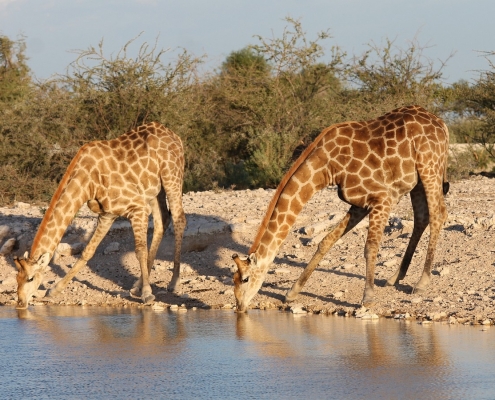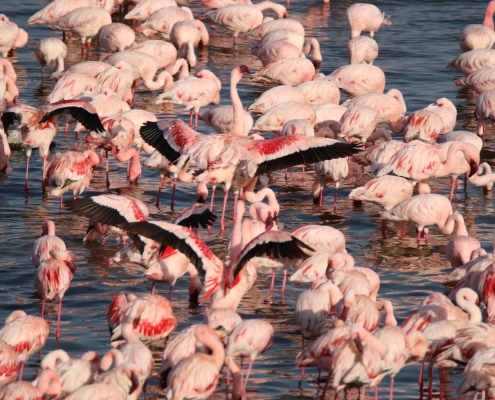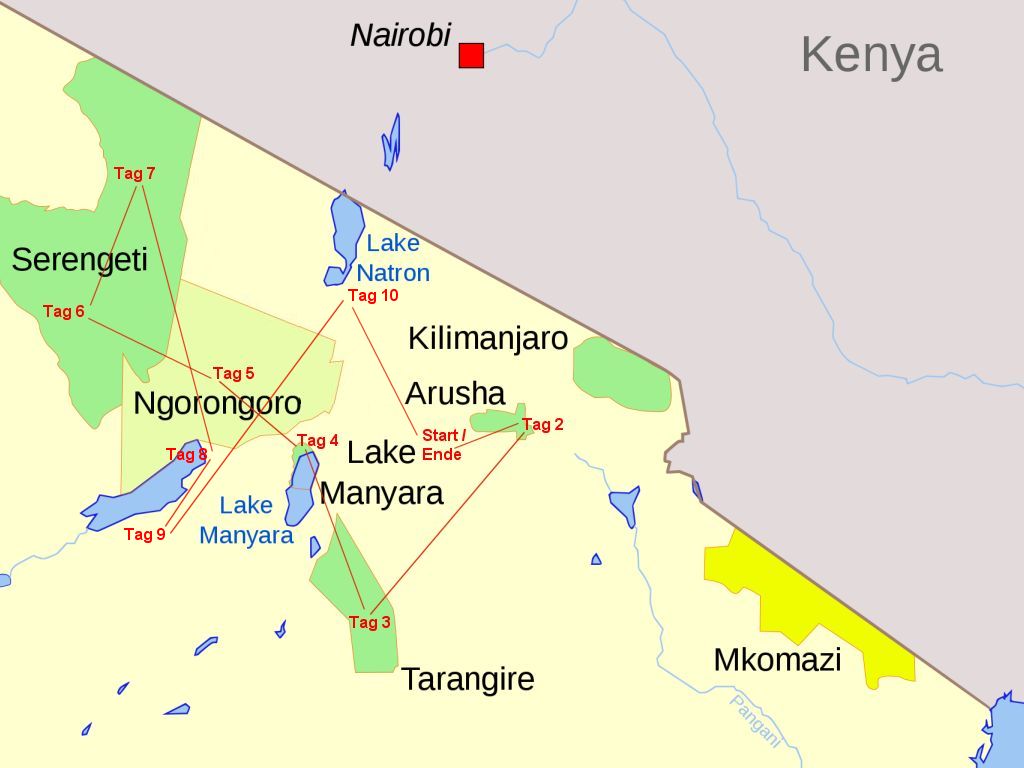12 Days Safari Northern Circuit with Lake Natron and Lake Eyasi
brief overview
This tour includes a twelve-day safari with a specialized 4×4 vehicle to the five most famous national parks in Northern Tanzania and to the protected areas at Lake Eyasi and Lake Natron. On this safari you will experience all the highlights of the Northern Circuit and will visit the Ngorongoro Crater, Lake Manyara National Park, Arusha National Park, Serengeti National Park and Tarangire National Park. This safari will also take you to Lake Eyasi with the last bushmen of Tanzania, the Hadzabe, and Lake Natron with Ol Doinyo Lengai, the sacred mountain of the Masai.
The Safari is designed for travelers who have enough time for an extended trip and are interested in the remote areas around Lake Eyasi and Lake Natron. Guests choosing this long safari will marvel at the countless impressions and experiences for years to come. This is truly a unique experience, the itinerary proposal is highly recommended.
Day 1: Arrival in Arusha
Transfer from Kilimanjaro Airport or Arusha Bus Station (e.g. via Nairobi) to your accommodation.
Day 2: Arusha – Arusha National Park
Today you go on your first real game drive. After a leisurely breakfast and a short introduction from your guide you will enter your 4×4 safari car/truck and start the drive towards Arusha National Park! Arusha Park is known for its abundance of tropical birds. With over four hundred different species in this relatively small park, you can easily spot them as you drive through the tropical rainforest! Often the lakes of the park are filled with thousands and thousands of flamingos, including the rare Greater Flamingo. The park also has some beautiful craters, waterfalls, mountains and grassy areas. The park is known as the home of the Colobus monkey, which you can recognize by its long tail. The name comes from its blunt thumb: Colobus is from the Greek colobos, which means stump. It is a rare monkey and therefore one of the reasons to visit the park.
A ranger will accompany you “full time” on your optional walking safari through this forest park. The ranger is an employee of the National Park Authority and carries a rifle over his shoulder in case you unexpectedly encounter buffalo, leopard or elephant. Of course the ranger does not shoot immediately, only if there is a real danger. You will find that it is a very special feeling to really enjoy the wildlife up close without the protective sheet metal of the safari vehicle: Giraffes walk past you on their stilts, you hear elephants trumpeting, in a clearing you see a troop of Anubis baboons. During the hike you will partly walk through dense mountain rainforest on the east side of the Meru volcano massif. In between you will have a picnic. You walk up the mountain for a few kilometres, the ascent takes about two to three hours and leads first through a green meadow and then through light acacia forests. From a certain height, the mountainous area follows, passing through dense, shady mountain rainforest. Here mosses, orchids, ferns and epiphytes dominate the landscape. Buffalos, bushbucks, elephants and Harvey Duckers love this terrain. The duiker belong with half a meter shoulder height to the smallest antelope species. The fur of these animals is mahogany brown, the horns are very short. In Dutch, the Duiker antelope are called “Duiker”, which means “diver”, a name that describes their behaviour during flight: At the slightest disturbance, the head is immediately submerged deep down in the dense undergrowth. Wild flowers, especially the extremely pretty fireball lilies, are a real feast for the eyes in between. After your hiking/animal-stalking tour you will go to your accommodation and a well-deserved dinner.
Day 3: Arusha National Park – Tarangire National Park
You leave Arusha after breakfast and drive about 1-2 hours to Tarangire National Park, circa 80 km away. On the way you will pass lively Masai villages and the wide plains for which East Africa is so famous. The Tarangire National Park is very large, all in all 2600 square kilometers, about the size of the german state of Schleswig Holstein. There are extensive gently undulating plains here, including two large pans in the south that turn into swamps depending on the season. After Serengeti, Ruaha and Mikumi, the Tarangire is the fourth largest park in Tanzania. It is named after the Tarangire River, which rises in the mountains south of the park. This river winds its way from the extreme south through numerous rocky hilly landscapes, which are between 1000 and 1675 meters high, almost to the northernmost tip of the game reserve. Here it turns westwards in a swerve and flows into Lake Burungi, which has no outflow and is located in the north-east of the park. There is water in the river all year round, very important for the local flora and fauna.
Once you reach Tarangire Park, you will begin your game drive through a hilly grass savannah landscape dominated by the imposing baobab trees (Adansonia digitata), which grow in abundance here. They are also known as Baobab trees. A picnic area overlooking the Tarangire River is a nice option for a lunch break. As you drive through the park, you will also have the opportunity to see elephants, lions, leopards, buffalo and a variety of antelopes. If you are lucky you may even see endangered animals such as the African wild dog. In the late afternoon or evening you will drive to your chosen accommodation.
Day 4: Tarangire National Park – Manyara National Park
Today we travel to Lake Manyara National Park; the protected area lies picturesquely as a narrow strip of shore between the western slope of the approximately 800-metre-high rift valley steep face and the soda-rich Lake Manyara. Although the park is not particularly large, it is, so to speak, a masterpiece in terms of its different habitats: the rocky Rift Valley escarpment, the groundwater forest, the acacia tree savannah, the open grass savannah, the lake shore, the numerous swamps and the lake itself. Lake Manyara National Park is one of the greenest and most exotic game reserves in the country. The biomass of animals that inhabit the park is enormous: the grass savannah is home to wildebeest, zebra, waterbuck, reedbuck, impala and Thomson’s gazelles. In the acacia groves bushbucks with their ivory-coloured spiral horns together with the small dikdiks stalk gracefully over the water-soaked ground. In the bush land you can find the massive and unpredictable buffalos again. The vegetation along the rivers is often a gallery forest, where dump palms and wild date palms grow. The trees provide the wild animals with plenty of shade and food. The tree-climbing lions are a well-known landmark of the park, these powerful predators pose on acacia trees and want to be photographed. Ornithologists will love Lake Manyara with its great variety of birds.
If you wish, you can visit the nearby market town of Mto Wa Mbu. This place with its agricultural and fresh products is a melting pot of local cultures and a paradise for souvenir hunters. The landscape of the area is green like an oasis. This change in the vegetation is due to the fact that the two rivers Kirurumu and Simba, which come from the Ngorongoro Highlands through porous lava rock layers underground, pour their water masses here at Mto wa Mbu into this otherwise barren rift valley zone. This is transformed into a particularly fertile area. There is plenty of cultivated land here, where a lot of vegetables and fruit are grown. In this market town there is a colourful life and bustle. It also has many “Dukas” here. These are shops where you can find everything from ebony carvings to colourful cloths. A speciality that should not be missed are the red bananas. You will certainly notice them immediately when you look at the fruit stands. They are shorter and thicker than conventional bananas, and they also have a fruitier taste. After the thrill and the many impressions of the day, you will return for dinner in your chosen accommodation.
Day 5: Manyara National Park – Ngorongoro Conservation Area
After an early morning refreshment you will drive to the Ngorongoro Conservation Area, also known as the 8th wonder of the world. The tarred road takes you higher and higher up to the Ngorongoro crater rim. The road climbs steeply in serpentines through a noticeably cool, fairytale mountain forest on the outer slopes of the crater. After a few kilometres you will reach the Loduare Park gate, the entrance to the Conservation Area. After completing the entrance formalities, the journey continues uphill through ever denser jungle with bearded lichens and ferns. The tension rises, as it is not far to the edge of the world-famous Ngorongoro Crater. After a short ride the highest point and the first viewpoint is reached at a height of 2286 meters. From the edge of the crater to the crater floor it is about 650 meters altitude. If you look down, you can see savannah areas, swamps, rivers, forests, small hills and the soda lake, which is called Lake Magadi here. With the help of binoculars you can see herds of buffalo, wildebeest, zebra and gazelles walking on the crater floor. Afterwards you will descend into the crater and start a spectacular game drive in the crater floor.
The Ngorongoro Conservation Area is home to over 120 species of mammals, including the legendary Big Five. The crater area is home to around 20,000 large mammals – buffalo, zebra, antelope, elephant… There are over 100 lions and more than 400 spotted hyenas. It is one of the most popular safari destinations in the world and one of the few places in the world where the black rhino can be seen. The Ngorongoro Crater is not a crater in the true sense of the word. Geomorphologically it is a caldera, which means that after its last eruption its crater cone collapsed in the middle after the lava flowed out and formed this enormous crater bowl. It is the sixth largest caldera on the mainland of the earth. In the late afternoon or evening your guide will take you back to your accommodation.
Day 6: Ngorongoro Conservation Area – Serengeti National Park
Today you can look forward to the highlight of your trip – a Safari in the legendary Serengeti National Park. Many of the most famous nature films and documentations were shot in this world famous national park. The word Serengeti comes from the Maasai language and literally means “endless plains”. Many predators roam these vast plains; over four thousand lions, 225 cheetahs, thousands of leopards, 3500 hyenas and hundreds of wild dogs. After breakfast, continue along the western crater road until the trail leads you downhill directly into the Serengeti. On your left is the “Malanja Depression”, where the Maasai lead and graze large herds of cattle for watering. Behind it you will see the 3107m high extinct volcanic mountain Lemagrut. After another 20 km there is a steep cliff on the left side. Huge rocks have rolled down the mountain here. Now you have reached the plateau, the wonderland of the Serengeti. The landscape is flat and there are only a few trees: a sea of grass, so to speak, as far as the eye can see.
According to your wishes you will drive to your chosen accommodation in the South Serengeti for a short refreshment. In the afternoon you will go on a game drive with your guide. Alternatively, you can enjoy the rest of the day and let your cook or lodge staff pamper you.
Day 7: Serengeti National Park
Today you get up before sunrise and continue your Serengeti Safari with an early morning game drive. As the sun begins to illuminate the savannah, you will have the best opportunity to see predators in action as they take advantage of the low light and cooler temperatures to seek an early meal. It is an ideal time to see lions, leopards and cheetahs in action as well as the movements of wildebeest, zebra and other herbivores. Alternatively you can book a hot air balloon safari at sunrise followed by a champagne breakfast.
After your unforgettable morning, return to your lodge for a late breakfast and refreshment before heading back out onto the road with a picnic. Your driver will choose the best possible route based on the season and the type of animals you wish to see. This way you can make your day as enjoyable as possible to observe the diverse wildlife of the Serengeti. Depending on the season, you will have the opportunity to observe the great animal migration. Details about this “Great Migration” can be found in our dedicated article. After an exciting day in the vast savannah of the Serengeti you will return to your accommodation in the evening.
Day 8: Serengeti National Park – Karatu
After breakfast you leave the Serengeti for the Ngorongoro Conservation Area. The drive takes you back through the Serengeti along a beautiful route and offers the opportunity to see some animals you may have missed earlier – wildebeests and zebras in huge groups, large and graceful giraffes, leaping antelopes and gazelles, the mighty African elephant or the elegant predators. After you have left the gates of the reserve behind you, you drive about 30 minutes further to the small town of Karatu. Here you have the opportunity to stop at some of the many “dukas” (small shops) and to buy some souvenirs for home. The fertile soils of the area are intensively cultivated by small farmers. You can look forward to a variety of tropical fruits, fruit and vegetables that are offered for sale by Tanzanian mamas. Haggling and negotiating is part of the sale here. Afterwards you return to your accommodation for dinner.
Day 9: Lake Eyasi
After an early morning picnic, today you’ll head to Lake Eyasi, home to the Hadzabe Bushman ethnic group, traditional hunter-gatherers with a similar way of life to the Bushmen of southern Africa. The area around Lake Eyasi is a wild, almost unexplored and impressive landscape with very few visitors. Lake Eyasi is an alkaline lake that stretches about 50 km southwest. In the northeast the impressive crater highlands dominate the horizon, in the north the plains of the Serengeti.
After you have checked in at your accommodation, a Bushman will guide you on traditional hunting trails. The small people of this indigenous tribe are probably the last to live in true harmony with nature and have a wealth of knowledge of flora and fauna that they are happy to share with visitors. They live in groups that hunt with bow and arrow and collect roots, tubers and wild fruit. The Hadzabe are excellent archers; a useful talent for hunting birds, for example, which the Bushmen like to show off. It is also interesting to learn how to start a campfire without a lighter or matchbox. One can also visit the Datoga tribe, an ethnic group of cattle ranchers known for their colourful leather clothing. After these educational encounters with foreign cultures you will drive to your lodge or campsite for dinner.
Day 10: Lake Natron
In the morning you will pass the village of Engaruka towards Lake Natron on a partly bumpy and dusty road. On the way you will see many Masai villages, termite mounds, gazelles, giraffes, zebras, baboons and birds like vultures, ostriches and giant bustards. After about 4 hours drive you will reach Lake Natron. In total the lake is about 60 km long and 20 km wide, but since it is mainly fed by rainfall, its extent varies a lot. So at the peak of the dry season it can shrink to about 2 km width. Sometimes the shallow lake dries up completely and leaves a white salt crust. Accordingly, the area of the soda lake fluctuates between 800 square kilometres at the end of the rainy season and one square kilometre towards the end of the dry season, depending on how much rain has fallen in the region. As soon as the water level falls, the lake immediately divides into two areas, with a large northern half and a much smaller southern half. At the edge, where the lake bottom has dried up, it ruptures and at the cracks soda presses down, so that e.g. from a higher location, huge honeycomb structures can be seen. These are coloured red at their edges, partly by purple bacteria. Further out in the lake, where the water is deeper, there are spiral-shaped geysers – often several hundred metres in diameter – which pump hot saturated soda lye.
In the afternoon you can take a trip to the waterfalls and discover the source of the Ngaresero River, which leads you through a dramatic cliff amphitheatre. This is a 20 to 30 minute walk up the Ngaresero River through a deep canyon valley; for this walk, canvas sneakers are highly recommended, which can get wet and dry soon after. The landscape here seems wild and isolated, almost untouched by human hands. There are a few easy climbs and sometimes you have to cross or wade through the river to get to the waterfall. After the last few meters on the stone bank of the river you finally reach the waterfall: Your efforts so far will be rewarded by a beautiful pool in the middle of a tropical landscape with naturally clear, pure water. Bathing is very possible here and a perfect way to cool down from the hike. Afterwards you return to your accommodation at Lake Natron.
Day 11: Lake Natron – Arusha
After an extensive breakfast you will go on a partial ascent of the active volcano Ol Doinyo Lengai in the early morning. Alternatively, you will visit a traditional Maasai settlement and get exciting impressions of the culture and daily life of this Nilosaharan tribe.
You will first return to Engaruka, where you can find ancient ruins from an unknown civilization – there are only foundations left however. From there it is another 55 km until you reach the main road at Mtu wa Mbu. The road runs along the east side of the great rift valley wall, which is covered by the cool, forested Ngorongoro Highlands. The dirt road is in places quite bad with deeply washed out fairways. You will pass through an endless dry savannah covered with grass and thornbushes. You pass countless termite mounds, but also various Maasai krals. The track is quite sandy in places and your strong four-wheel drive vehicle is just right for this section. About 15 km before Mto wa Mbu you reach another small village called Kitete. In the afternoon you will reach Mto wa Mbu. Here the journey now leads you back on a good tarmac road towards Arusha and your chosen accommodation.
Day 12: Arusha Safari End
End of your 10 Days Northern Circuit Serengeti Safari in Arusha. After breakfast transfer to the central bus station, to the airline office in the city for your shuttle bus to the airport or extension e.g. onward flight to Zanzibar.
Itinerary
Day 1: Arrival in Arusha
Day 2: Arusha National Park
Day 3: Tarangire NP
Day 4: Manyara NP
Day 5: Ngorongoro Conservation Area
Day 6: Serengeti NP
Day 7: Serengeti NP
Day 8: Serengeti NP – Karatu
Day 9: Lake Eyasi
Day 10: Lake Natron
Day 11: Lake Natron – Arusha
Day 12: Safari End, Arusha


